
Family Pond Photo
Hello readers!
It's hard to believe that it's been more than a year since my last update (back in September 2013). The past eighteen months dealt us two of the coldest and snowiest New Jersey winters in recent memory. And while this caused some problems, we also learned new things as a result. For example, we lost both bee colonies during the 2013-2014 Winter season, but then we had a record honey harvest later that Fall.
And with Spring 2015 knocking at our door, this is a good time to pause for some writing... before we get back out to work!

Family Pond Photo
We had an early snowfall in December 2013 so I positioned the picnic bench in front of the pond and we pushed the kids outside for a holiday photo. They groaned, naturally, making this one of my more difficult pond projects, but it came out pretty nice... apart from that one guy on the far right! :-)
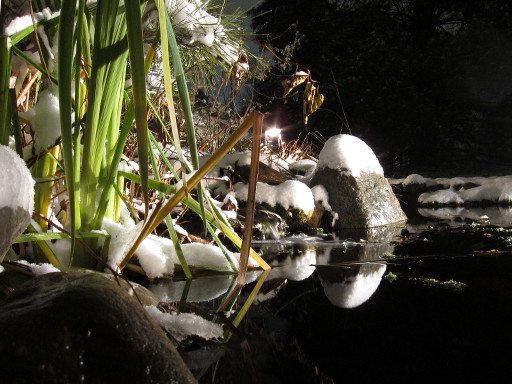
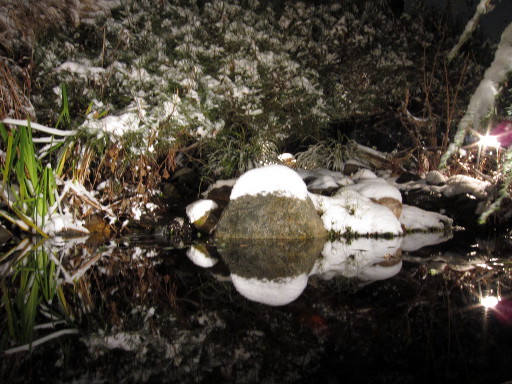
Winter Pondscapes
Winter 2013 was off to a picturesque start! Here are a couple more pondscapes from early December. I always like how the white snow contrasts with the darkness of the water. And the mirror perfect reflection is an added bonus.
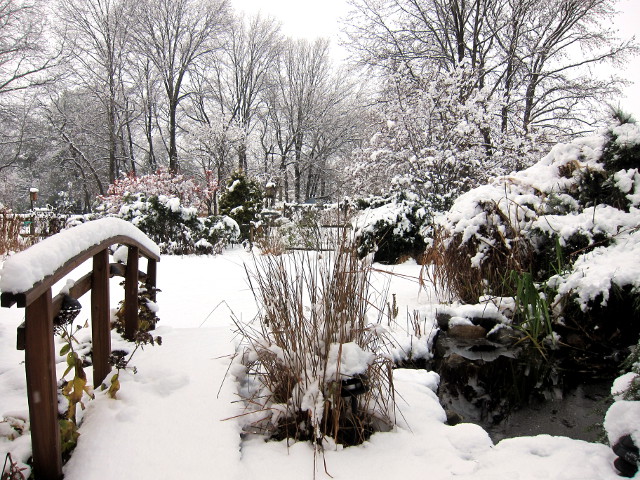

A Splash of Red
It's mid-December 2013 and a bit more snow has fallen. If you look in the background, there above the bridge, you will see the bright red berries of the Ilex Verticillata. These provide beautiful red color to any drab Winter landscape. And in the early Spring when the berries ripen, the songful Mockingbirds will drop by for a feast!
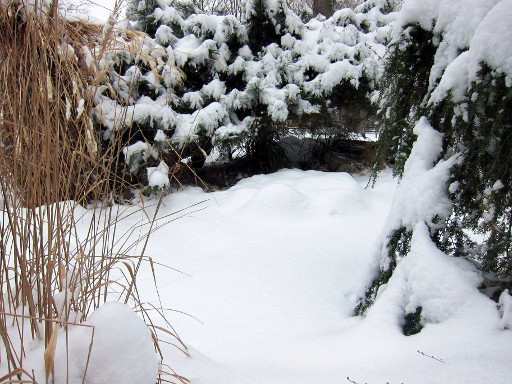

Where's the Pond?
Now let's skip ahead one year to February 2015. Can anyone find the pond in these photos?? While difficult to see, if you were standing here, you would have at least heard it because the water is still flowing under all that ice and snow!
We actually didn't get a lot of snow this past Winter, but what fell to the ground never had a chance to melt. February's average temperature of 22 degrees made this the 3rd coldest (and 6th coldest month) since recordkeeping started in 1895.
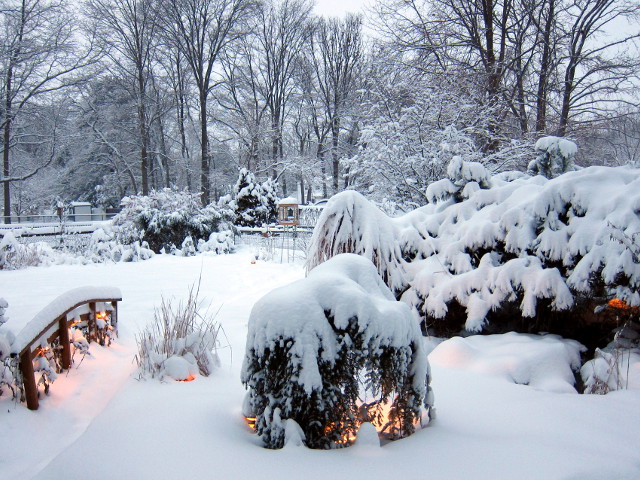
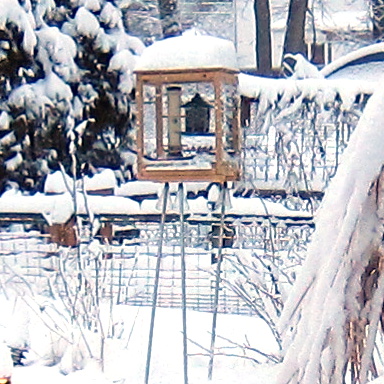
March 2015 Snowstorm
And now it's March 5th, 2015 and we have 8 more inches of snow on the ground! Wonderful. We haven't seen the lawn since December... speaking for everyone here, we have had enough of Winter at this point.
In the center of this picture, the careful observer will notice our
new bird feeder over by the garden.
And I'm going to use that as my segue
to transition from this barrage of Winter photographs...
Yes, let's leave Winter behind and take a closer look
at that new bird feeder!!
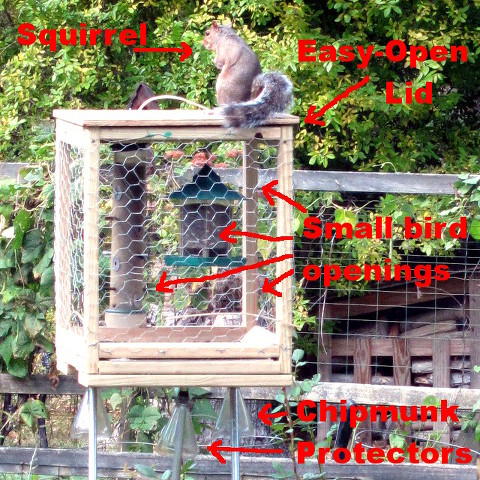
The Squirrel-Proof Bird Feeder
Squirrels are ingenuitive animals and I have nothing against them. It's just that, I like to feed thistle and sunflower seeds to the smaller birds that overwinter here, and keeping squirrels out of the bird food is a constant challenge. So my father-in-law built this inexpensive squirrel-proof bird feeder for us and this thing really works!
The square frame is made from pressure treated wood wrapped in one inch chicken wire. A pair of feeders hang from the removable lid; simply pull up the rope handle and unhook the feeders to refill them. Three metal conduit pipes support the feeder above ground and plastic water bottle tops keep the equally clever chipmunks down below. Since the one inch holes were still a little small for birds, I cut a wire on some of the holes to widen them. I then used hot glue to ensure there were no sharp metal edges. Later I added sticks for the birds to perch on when entering and leaving.
For the first month or so, squirrels would stop by and gnaw at the wire, but eventually they all gave up and moved on. I was also surprised to find that some of the birds could fly straight through the holes and land at the feeder without stopping... if I had a high-speed camera, I suspect it would look something like this!
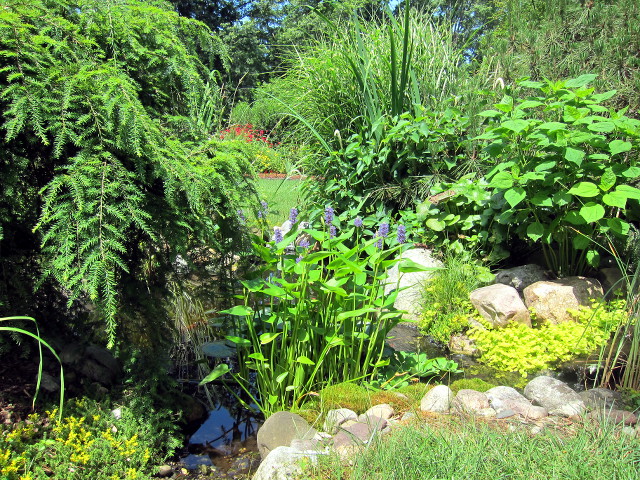
Summertime!
It's June 28th, 2014 and colors abound! The higher purple flowers in the forefront stem from our perennial pickerel weed. And floating on the water to their immediate right is the offspring of the two water lettuce plants Catarina bought this year... they multiply fast!
Water lettuce are an invasive species, however since they cannot survive the New Jersey Winter, they are entirely beneficial here. They consume excess nutrients in the water (to reduce algae), provide shade for the fish (who also nibble at their roots), and create the perfect landing pad for honey bees looking for water. And once harvested, they make for great compost... and I have to harvest these things a few times every year! :-)
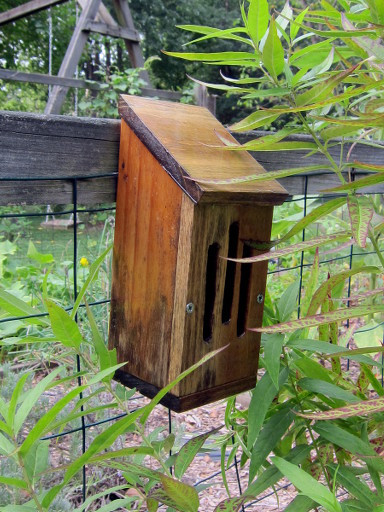
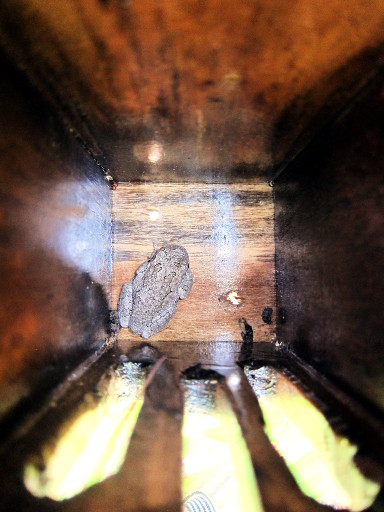
Frog in a Butterfly House
My son Axel built this butterfly house at Home Depot Kids WorkShop many years ago. And while I have yet to see a butterfly inside, I did find a Gray tree frog this past Summer! For a week or so in mid-August, this nocturnal frog could be found sleeping the days away here in the butterfly house. And then one day, it was gone. Maybe a butterfly kicked him out?
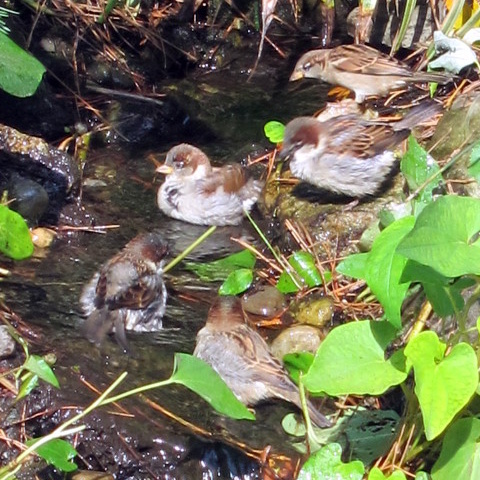
Sunshine means Bathtime!
There's a mid-October chill in the air, but that won't keep these Sparrows from their daily bath. This day started off overcast and drizzly, but as soon as the sun popped out, they flocked to the streambed above the left waterfall for a refreshing dip.
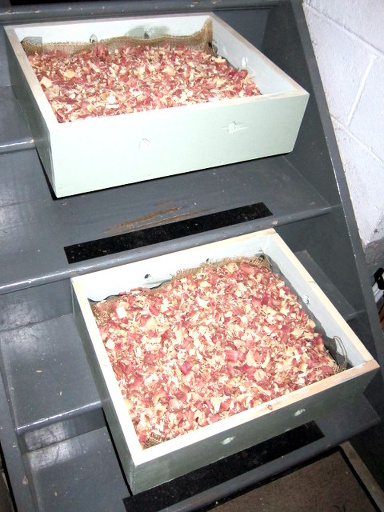
Lost Bee Colonies
As I mentioned at the start of this update, we lost our honeybee colonies in January 2014. Both hives had plenty of honey and the dead bees did not look ill, so I concluded the cause was neither starvation nor disease. I also noticed that both hives were very damp and, while bees are adept at controlling the climate inside their hive, dampness in Winter can still wipe them out. So what I suspect happened is, the warm moist air inside the hive rose to the top and condensed on the cold plastic outer cover. The water then dripped back down into the hive creating a cold, damp climate which ultimately killed both colonies.
What to do?? Pictured above is my homemade solution to this problem. These two boxes are called moisture quilts and, this past Winter, I placed one on each hive between the wooden inner cover and the plastic outer cover. The idea is pretty simple. Warm moist air inside the hive will rise up through a screen covered with cedar shavings. The water still condenses on the plastic cover, but instead of dripping back into the hive, it now falls on the cedar shavings which absorb it. Cross-ventilation holes allow the cedar shavings to dry out, while down inside the hive, the bees stay warm and dry.
So in the Spring of 2014, we received and installed 2 new honeybee packages. The first was another Italian bee colony, and the second were Buckfast bees. In years past, I had also been having trouble with Small hive beetle infestations and my attempts to control them met only with limited success. Besides being a destructive pest, the hive beetle can also weaken bee colonies. So last year, I tried a new product called the Beetle Baffle on both hives.
And how did we do???
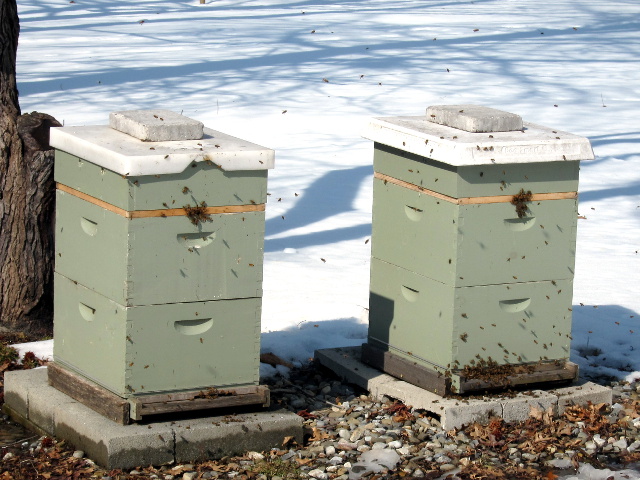

Result!
The sun came out on March 8th, 2015 and so did all the bees! This is what every apiarist wants to see as Spring approaches. It looks as if both the Italian colony (on the left) and Buckfast bees came through the cold and wet Winter in fine form. You can still see the moisture quilt boxes installed under the top cover, but I'll be removing those soon. The temperature is around 55 degrees today, so both colonies are busy removing the deceased bees, stretching their wings, and paying visits to the Crocus plants now springing up in our front yard.
I also had been checking for those destructive hive beetles over the course of the Summer and into the Fall. I'm happy to report that I never saw a single beetle in the Buckfast hive and saw only one in the Italian colony. The Beetle Baffle clearly lives up to its name!
Finally, both colonies combined to deliver over 4 gallons of honey in the Fall of 2014! That's the most we ever collected!! And while I don't know what this year will bring, it sure looks like these bees are off to a great start!

